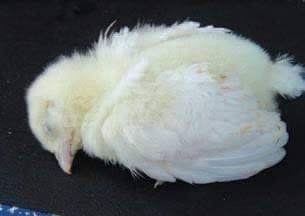🔥E- book offer of the day: 👉👉 Poultry farming business report Volume 4
Clinical Signs of E.coli infection in Broilers
Clinical signs vary from inapparent to total unresponsiveness just prior to death depending on the specific type of disease produced by E. coli.
Localized infections generally result in fewer and milder clinical signs than systemic diseases.
 Learn More
Learn MoreColiform cellulitis is typically not detected until the birds are processed.
Lameness and retarded growth are seen in birds with skeletal lesions that develop as a sequel to sepsis. When joints or bones of 1 leg are affected, birds walk with a characteristic hopping motion to keep weight off the affected leg.
Birds with lesions in both legs are either nonambulatory (do not move) or have great difficulty in standing and walking.
When the thoracolumbar spine is affected, the birds have an arched back, sit on their hocks, and bear little or no weight on their feet.
Purchase this compelling ebook instantly. 👉👉21 most important poultry diseases with prevention, control & treatment
Occasionally they will sit back on their tail and hocks with their feet elevated off the ground.

READ ALSO Effective Strategies for Managing Heat Stress in Birds
Birds with chronic lameness have caking of droppings around the vent and on abdominal feathers.
Severely affected individual birds are unresponsive when approached, do not react to stimuli, and are easily caught and handled. Look into the video for the clinical signs discussed above
They sit with their eyes closed in a hunched position with drooping of the head, neck, and wings. The beak may be inserted into the litter to support the head.
Don’t wait – buy this captivating ebook right away.👉👉 Poultry farming business report Volume 5
Affected birds are typically undersized for the flock and found at the ends of the house, along the side walls, or under feeders or waterers.
Birds with colisepticemia are often terminally moribund or very lethargic.
READ ALSO 15 Elements of poultry broiler farming success at your fingertips
Decreased water consumption is associated with a poor prognosis.
They may be victims of “cannibalism” by other birds.
Feces are green with white to yellow urates because of anorexia and dehydration.
Young birds with omphalitis and infected yolk sacs also may have difficulty in walking because of abdominal distention, which alters weight distribution and impairs balance.
ATTENTION: Click “HERE” to join our WhatsApp group and receive More updates directly on your WhatsApp!
Dehydration is indicated by dark dry skin, which is especially noticeable in the shanks and feet.
Dehydrated young chicks typically have prominent raised folds of skin along the medial and lateral sides of the shanks and toenails that appear black.














